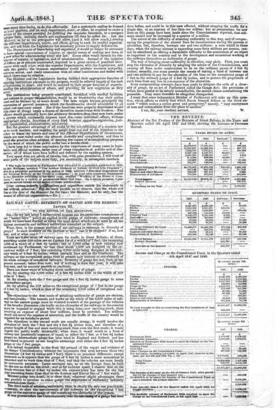RAILWAY GAUGE: DLVERSLIYAW.cGALVE AND ITS REMEDY.
' to Tint' qJ lLJ iii • 4 . . kry-trffiltflEk4'91•Z" Sui-In my last n
Ilet ql 93,4 ,pegneions conseouenoe of
our "laisSei faire" pohiç,aa p g ,f0P110; conseettlegoeti flf.
which We havibeeit warn VOA, be useckhy,„4,t4te highest mercantile and i'enbjedt.
What, then, is the pacpt, res• etaxliNtf to ?diivf soers,it of !gauge? Is such di beat, and at what cost F=0Thr)a`lt .411I to noTiaa airr ut Thin: ire 3400Mi1&t0ila1lw5' a fo rafflc in (reat ritaip: of,thwe, something uinisledtletniffit, 'Mite Stir Vrt,he kirittg 3,060 of a width 4.41 filet 8Vi arg.qif,t4 at '0 • s sanctioned,brPtifolfloo4
eeptional width- of featreherviiia
nary width of 4 feet 81 'Pt
railway on the exceptional oaiko *flit tPoifiP the whole mileage of completed rail
Faent moment, taken firm root; bit. 'WI-0110 1,4';
firm root, and be scarcely possible toeradieate. ' " There are three ways of lningibg about uniformity of gauge': let. By altering the 8,050 miles of 4 feet 81 inches wide to the width of 350 miles nf 7, feet ; 2d. By altering both the 7 feet gauge and the 4 feet 81 inches gauge to some iatennediate -gauge ;
3d.- By altering the 350 miles on the exceptional gauge of 7 feet to the gauge of 4 feet 8i inches, which is that Of the reinaining 3,050 miles of -completed rail-
way. - •
The objections to the first Mode of attaining uniformity of gauge are obvious, and inimperable. The tunnels and works on the whole of the 3,050 miles of rail- way on the narrow gauge must be widened to admit Of the passage of the vehicles of the broader dimension; the traffic on ten-eleventhaof the railways in the country must be impeded or stopped while this is being done; new carrying-stock, alone involving an expense of about four tnillions, must be -provided. Ten millions would not cover the expense of alteration, and the traffic of the country would be impeded for an indefinite period. The objections to the second mode are equally strong; it would involve the alteration of both the 7 feet and the 4 feet 8* inches lines, and therefore of a greater length of line and more carrying.stock.than even the first mode; it would impede the public traffic intolerably; when done, it would result in a form of railway not practically superior, if equal, to either the 7 feet or 4-feet 8* inches gauge; an intermediate gauge 'has been tried in England and Ireland, amid has been found to present no one tangible advantage over either the 4 feet 8* inches gange or the 7 feet gauge. It is indeed impossible to rise from the perusal of the report and evidence of the Gauge Commissioners, without the -impression that even between these two dimensions (4 feet 81 iimbes' and Tfeet) there is no practical difference; except inasmuch as it appears that the gauge of 4 feet 81 inches is more economical to conetract and to work than that of 7-feet, and that the vehicles are more handy for mercantile purposes. Large carriages can, as on the foreign lines, be built for the one as well as the other; and as for extreme speed, I observe that on the South-western line of 4 feet 8* inches the express-train has been for the last Year travelling faster than thatidit the London and Exeter line of 7 feet width. Without going into detail,- ills- that, whatever slight advantages there limy possibly be peculiar to either &Mtge the importance of uniformity infinitely oomiterbalinces them. -At.,h= -
The third mode of attaining uniforinity,Viett; dearly the only one practicable,
• -siainely, to alter the one-eleventh of 'ithd,fa?Fh*S. fitiffiWiexceptional freet gauge to the narrower gauge of the rernerdinettiffilfiethe system. It was proved before the Conunissionerk411lit flielithifeaterif it` gauge had lied done before, and could be in this case effected, without stopping the traffic for &- single day at an expense of less than one million: but as preparittiona for new lines on this gauge have been made since the Commissioners reported, that esti- mate should now be increased-by a quarter of a million. The extent of the difficulty of attaining uniformity in this way, and of compen- sating the proprietors of the altered lines for inconvenience during the process of alteration, lies, therefore, between one and two millions; a sum which in these days, when the railway interest is expending some forty millions per annum, can- not be considered as offering a formidable difficulty to the altainment of an object so important to the :country and to the development and economical working of the raj/ways themselves as uniformity of gauge. The way of bringing about uniformity is, therefore, very plain. First, you must stop the extension of diversity by adopting the advice of the Commissioners, and causing all lines' under construction to be on the ordinary gauge of 4 feet 81 inches; secondly, you must provide the means of raising a fund of between one .and two millions to pay for the alteration of the lines on the exceptional gauge of 7 feet to the ordinary gauge of 4 feet 8* inches, and to protect the proprietors of such lines from any loss II] con equence of the alteration. Some compromising attempts have been made to Mitigate the evils of a diver- sity of gauge, by an act of Parliament- called the Gauge Act; the provisions of which have proved tOboutterly uuiutelligible, the Second clause contradicting the preamble. They mast therefore be altogether disregarded.
I trust that some independent Nember of Parhament,viill.take pp this ques- tion, which, affects so closel/ that whiCh Bacon himself defines as the third ele- nient " which makes a nation great and prosperous," namely, ": easy conveyance of men and'eniinhodities from one' place to another."
I am, Sir, your obedient servant,


























 Previous page
Previous page